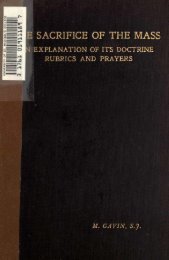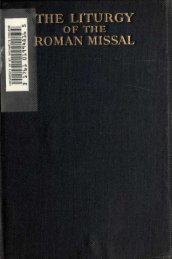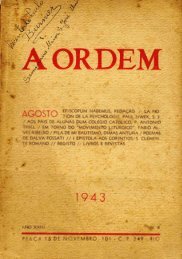E SACRIFICE OF THE MASS
E SACRIFICE OF THE MASS
E SACRIFICE OF THE MASS
You also want an ePaper? Increase the reach of your titles
YUMPU automatically turns print PDFs into web optimized ePapers that Google loves.
98<br />
<strong>THE</strong> SECOND PRAYER IN <strong>THE</strong> CANON.<br />
<strong>THE</strong> SECOND PRAYER IN <strong>THE</strong> CANON<br />
BEFORE <strong>THE</strong> CONSECRATION.<br />
Spreading his hands over the oblation, the priest says :<br />
Hanc igitur oblationem ser- We, therefore, beseech<br />
vitutis nostrae, sed et cunctae Thee, O Lord, to be appeased<br />
familiae tuae, quaesumus and to accept this oblation of<br />
Domine, ut placatus accipias ; our service, as also of Thy<br />
diesque nostros in tua pace whole family ; dispose our<br />
disponas, atque ab aeterna days in Thy peace, command<br />
damnatione nos eripi, et in us to be delivered from<br />
electorum tuorum jubeas eternal damnation, and to<br />
grege numerari. Per Christum be numbered in the flock of<br />
Dominum nostrum. Amen. Thy elect. Through Christ<br />
our Lord. Amen.<br />
While saying these words the priest holds his hands<br />
over the bread and wine and the thumbs are stretched<br />
one over the other in the form of a cross. This gesture<br />
signifies the transfer of something to another. In<br />
Exodus (xxix. 10), before the calf is killed we read that<br />
" Aaron and his sons shall lay their hands upon his<br />
"<br />
head," and again in Leviticus :<br />
(i. 4) And he shall put<br />
his hand upon the head of the victim." This laying of<br />
hands implied the consciousness of guilt in the person<br />
who performed the act, and the wish to transfer to the<br />
victim those sins for whicb the victim was to die instead<br />
of the sinner. Here at the Mass, by the imposition of<br />
hands, tbe priest signifies that the sins of the world are<br />
carried by our Lord who died for them on the Cross<br />
"who bore all our iniquities on the Tree." The<br />
Mass is the re-presentation of that Sacrifice on Calvary.<br />
This imposition of hands at Mass did not always exist<br />
in the Church : it was introduced at the end of the<br />
fifteenth century ; and it was prescribed by St. Pius V.<br />
as a general law.






